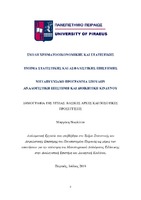Δημογραφία της υγείας: βασικές αρχές και ποσοτικές προσεγγίσεις
Health demography: theoretical and empirical framework and techniques of demographic analysis

Προβολή/
Λέξεις κλειδιά
Δημογραφία της υγείας ; Προσδόκιμο ζωής ; Πληθυσμός ; Δείκτες υγείας ; Στατιστική ανάλυσηΠερίληψη
Δημογραφία είναι η επιστήμη, που ασχολείται με τη στατιστική μελέτη των πληθυσμών με σκοπό την εξαγωγή συμπερασμάτων βάσει διάφορων συνθηκών, ενώ η επιδημιολογία είναι η μελέτη των μεταβολών και της εξέλιξης διάφορων νοσημάτων στον ανθρώπινο πληθυσμό και των παραγόντων που τις επηρεάζουν. Ανεξάρτητες έννοιες που ιστορικά φαίνεται να συνδυάζονται για συμπεράσματα που αφορούν την κατάσταση της υγείας του πληθυσμού με κοινά σημεία την ατομική υγεία, την υγεία του πληθυσμού, την γεωγραφία, τον χρόνο αλλά και διάφορους βιολογικούς και ψυχολογικούς παράγοντες. Το πιο κοινό δημογραφικό φαινόμενο είναι η γήρανση του πληθυσμού. Το ερώτημα που έχει δημιουργηθεί είναι κατά πόσο η μείωση της θνησιμότητας των γηραιότερων πληθυσμών, σηματοδοτεί και την ταυτόχρονη μείωση νοσηρότητας και αναπηρίας. Με άλλα λόγια, κατά πόσο τα επιπλέον χρόνια των γηραιότερων πληθυσμών συνοδεύονται από καλύτερη ποιότητα υγείας. Για την μελέτη και απάντηση παρόμοιων ερωτημάτων έχουν δημιουργηθεί δείκτες καταμέτρησης της υγείας, όπως οι DALE, DALY, QALY, HALE, ADL και IADL, οι οποίοι αναλύονται διεξοδικά στο πλαίσιο της διπλωματικής εργασίας. Επιπλέον, διεξάγεται ένα από τα κυριότερα μέσα αξιολόγησης των αλλαγών θνησιμότητας και υγείας του πληθυσμού, που είναι οι πίνακες επιβίωσης υγείας ζωής (Health Life Tables), όπου μελετάται το χρονικό διάστημα στο οποίο το άτομο κατά μέσο όρο προσδοκά να είναι υγιές ή μη κατά τη διάρκεια του κύκλου ζωής του.
Σε μεγάλο βαθμό, η διπλωματική εργασία εστιάζει στην σημαντικότητα των στατιστικών και των μέτρων υγείας και αναλύει τις εφαρμογές τους αλλά και τα πλεονεκτήματα που προκύπτουν από την εφαρμογή τους. Επίσης παρουσιάζει ευρήματα όπως μελέτες που αφορούν της χώρας μας, με σκοπό την διεξαγωγή συμπερασμάτων για την κατάσταση της υγείας του ελληνικού πληθυσμού.
Σκοπός της εμπειρικής προσέγγισης είναι να αναλυθούν τα δεδομένα της κατάστασης υγείας, που αντλήθηκαν από το πρόγραμμα Share το 2015 και αφορούν δείγμα ατόμων άνω των 50 ετών από διάφορες χώρες της Ευρώπης. Τέλος, υπάρχει μία σημαντική αναφορά και ανάλυση της εφαρμογής των μοντέλων λογιστικής παλινδρόμησης για την διεξαγωγή συμπερασμάτων της κατάστασης της υγείας του Ευρωπαϊκού πληθυσμού.


